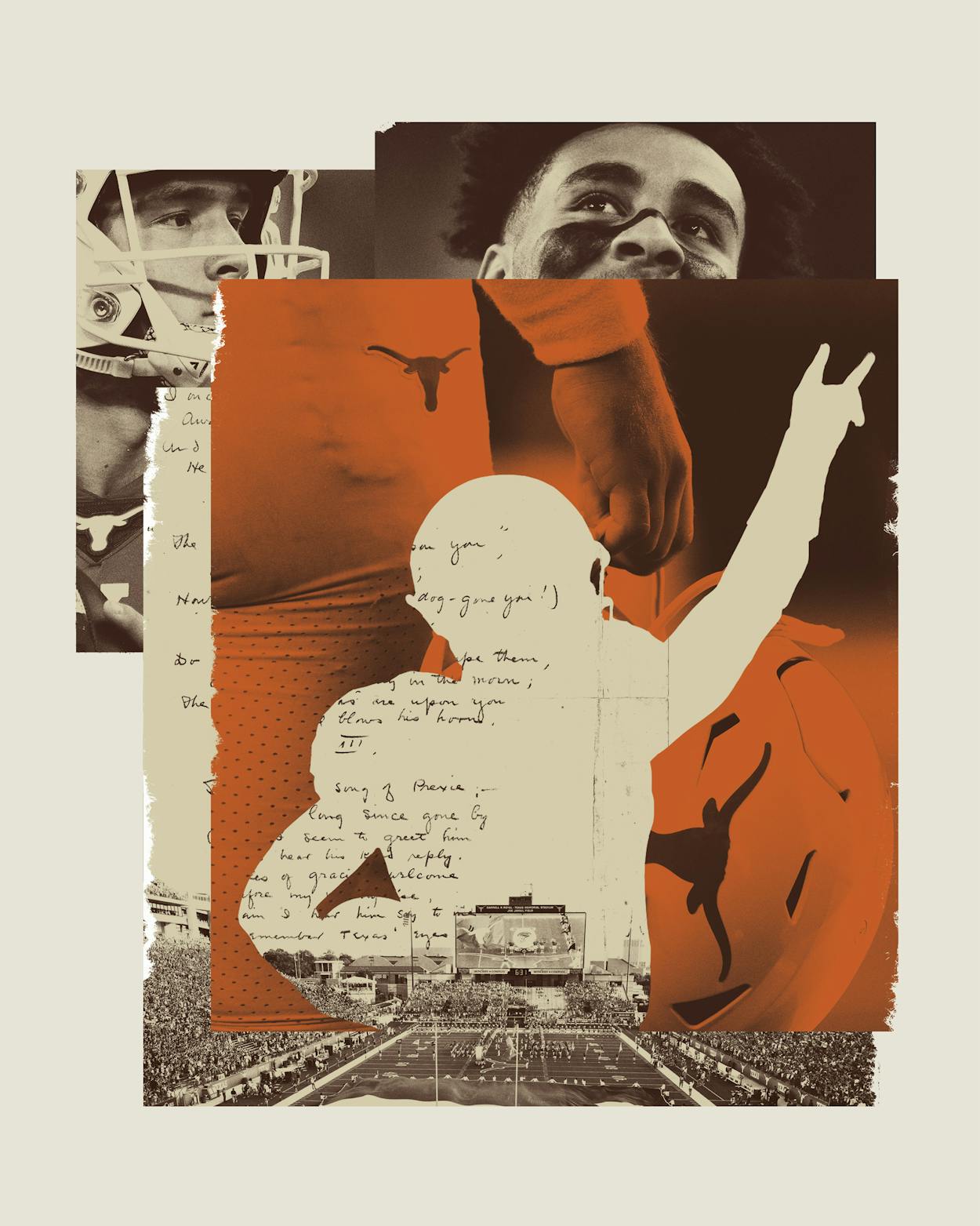When you go back and look at it, really look at it, it’s not even a good image. It was shot on a phone. It’s strangely cropped. Blurry.
But it sure captured a moment.
The photo taken of University of Texas quarterback Sam Ehlinger at around 4 p.m. at the Cotton Bowl stadium, in Dallas, on the second Saturday of last October, carved its own path, the way that viral social media posts and the most destructive tornadoes do. Maybe you heard it cost a coach his job. Maybe you saw it and felt outrage at the supposed lack of respect it depicted. Maybe you cheered the young athletes who protested a song with racist origins.
But the story the photo tells isn’t exactly what happened.

Several minutes had elapsed since Oklahoma had beaten Texas, 53–45, in a four-overtime thriller that ended when Ehlinger threw an interception in the end zone. Ehlinger’s helmet now hung from his left hand, while he held his right hand up in the “Hook ’em, Horns” sign. He stood at attention during the playing of “The Eyes of Texas,” the university alma mater. It’s odd that the photo has often been described as showing Ehlinger alone. There are about a dozen others—mostly coaches and trainers—in the frame, all facing away from the camera.
But the reason this photo rekindled the brushfire that had consumed much of the Texas football program in 2020, is that not a single one of those others is a Longhorn football player.
Zoom out a little, and you’ll see a different narrative. Defensive tackle Ta’Quon Graham also stayed out there for the song, standing about five yards out of frame. Other Longhorns remained on the field as well.
If you could add sound to the image, you’d understand that the Cotton Bowl’s tinny PA system made it hard to hear “The Eyes of Texas,” and many didn’t even know it had started to play. If you were able to rewind a few weeks, you’d see that much of the scene captured after the Oklahoma game mirrored the aftermath of the three previous contests. By then, nearly every UT player had made a habit of leaving the field after the final whistle, protesting “The Eyes of Texas” because of its roots in minstrelsy.
But the photo didn’t say all that.
For four seasons, the TV networks had made an almost weekly refrain of how Ehlinger, a preseason candidate for the Heisman Trophy and a star of the college football hype machine, played to honor his late father, a Texas grad who took Sam to games as a child. The news stations had gotten a lot of mileage out of an Ehlinger family photo of Sam as a young kid in overalls, putting his horns up. So, for many Longhorn fans who saw the photo, it said: Here’s the only player who loves his school. Here’s a player who’s done everything he could to help his team defeat its rivals. Where are his teammates? The photo said they didn’t care about the University of Texas.
The photo is wrong. It’s wrong about that, and it’s wrong that it cost the coach his job. But that should come as no surprise. If you had to pick a theme for the last twelve months of Longhorn football, it just might be miscommunication.
After the photo went viral, alumni and students flooded the in-boxes of university officials with impassioned emails, some of which were published by the Texas Tribune. The spectrum of reactions ranged from a donor who suggested that the university encourage Black students to “select an alternate school….NOW!” to a UT freshman who said, “If something offends a certain demographic of people, and they’ve been outspoken about it, and they have every right to be offended by it, I think we should be listening to them.”
One donor wrote about the protests, “My wife and I have given an endowment in excess of $1 million to athletics. This could very easily be rescinded if things don’t drastically change around here.” Cain & Abel’s, an Austin bar, printed shirts that said, “Stand With Sam.” Someone hired a plane to tow a sign with the same message during the next game.
Most of the players, meanwhile, only wanted an honest reckoning with the song’s history. “It’s not that the athletes would be winning by getting the song removed and boosters would be losing,” said Joseph Ossai, the team captain and star outside linebacker. “It’s about saying, ‘Is this morally right?’ ”
The tension had simmered since June, when, in the wake of the killing of George Floyd, a multiracial group of Longhorn athletes published a letter on social media requesting a series of changes to make UT more equitable and inclusive. The final request urged the school to get rid of the alma mater. The resulting dispute, initially about a song, quickly transformed into a discussion about belonging and control and, really, about the soul of the university: Who is welcome at UT? Who gets to decide what it represents?
The 2020 Texas Longhorns will be remembered much longer than most 7–3 teams. This controversy will be their legacy. In interviews with dozens of coaches, athletic department officials, university administrators, and current and former Longhorn players, Texas Monthly found that the players were largely left to navigate the turmoil by themselves. Said one source inside the athletic department, “Some people used these players, and others just sat on the sidelines and didn’t give them any help when they needed it.”

On June 1, seven days after the killing of Floyd—who died in Minneapolis but grew up in Houston—the Longhorn football team logged on for a three-hour Zoom call while protests erupted across the country. College football team meetings in the early summer of 2020 looked much like every other pandemic-era gathering. The players’ faces crowded the screen; they had to mute and unmute themselves. It was not the best forum for depth and nuance, but the Longhorns felt they needed to talk. Players voiced frustrations, asked questions, and discussed ways they could get involved.
At some point, athletic director Chris Del Conte expressed his support for the players. Over fifteen years as an athletic director at Rice, TCU, and, since 2017, UT, Del Conte had established himself as a fundraiser nonpareil, a tireless salesman. Del Conte knows how to make a pitch. He reminded the Longhorns that, as the public face of the university, they had a unique platform to inspire change. Use your voice, be united, and speak out, he told them. The players came away with an implicit message from Del Conte: if they took action, they would have the athletic department’s full support. The conversation expanded from there. What, exactly, could the Longhorns do to take advantage of the moment? On the Zoom call, one team leader brought up “The Eyes of Texas.”
The alma mater has been an integral part of the lives of UT alumni for generations. It is sung at weddings, funerals, and birthday parties, and, of course, by 100,000 fans at Longhorn football games. “The Eyes” was even sung in the movie Giant and, anachronistically, in the John Wayne film The Alamo (the battle was fought 67 years before the song was written). Elvis sang it in Viva Las Vegas, marching around a dance floor, beating a bass drum. Astronaut and UT alum Alan Bean famously had the lyrics printed on a piece of silk so that he could take them on his 1969 trip to the moon.
Del Conte had first experienced the hold that the alma mater has over his constituency in March 2019, when he attended the funeral of Johnny “Lam” Jones, the standout Longhorn wide receiver and 1976 Olympic gold medal sprinter, at Ebenezer Third Baptist Church, in Austin. “They sang the whole song as his casket was being laid to rest,” Del Conte said recently. It didn’t occur to him that it might be odd that this took place at the funeral of a Black man. “My point of view was, people sang the song with great pride,” he said. That would change. “I needed to educate myself too,” Del Conte said.
In truth, the song’s problematic history had been an open secret for years. Just two years before the football team’s Zoom meeting, the UT student government had debated the merits of “The Eyes.” About a decade ago, a group of Longhorn basketball players refused to sing it after learning its history. Neither movement caused a stir, but now that monuments to the United States’ racist history were toppling around the country, the song’s provenance got renewed attention.
“The Eyes of Texas” was completed in 1903. Lewis Johnson, a law student, attended Austin for the express purpose of writing a school song. He recruited John Lang Sinclair, an undergrad known as the campus poet, to help him compose the lyrics. They lived in Brackenridge Hall—the campus residence for poor students at the time. Sinclair wrote one tune, “Jolly Students of Varsity,” that they quickly consigned to oblivion. (For we are jolly students of the Varsity, the Varsity! We are a merry, merry crew.) Johnson asked Sinclair to try again, and when he came down with a case of writer’s block, a few members of the glee club locked him in his dorm room (according to some accounts, they actually forced him into his closet) with some cigarettes. They told him he couldn’t come out until he had a song.
A few hours later, Sinclair handed over a piece of brown paper, a wrapper torn from a laundry bundle. It contained the first draft of a poem, written in pencil, with words scratched out and revised. Lines five and six read, “The eyes of Texas are upon you, all the livelong day.” The line echoed the favored refrain of university president William Prather, who ended nearly every speech with the saying, hoping to encourage students to work hard and act with integrity. In a 1900 address, Prather explained to students that his saying was inspired by a Confederate brigadier general who once told his troops, “The eyes of General Lee are upon you!” Prather used the phrase so much that students started to make fun of him. At one event, one student leaned over to another and said, “Bet you a quarter he says, ‘Eyes of Texas.’ ” He won the quarter.
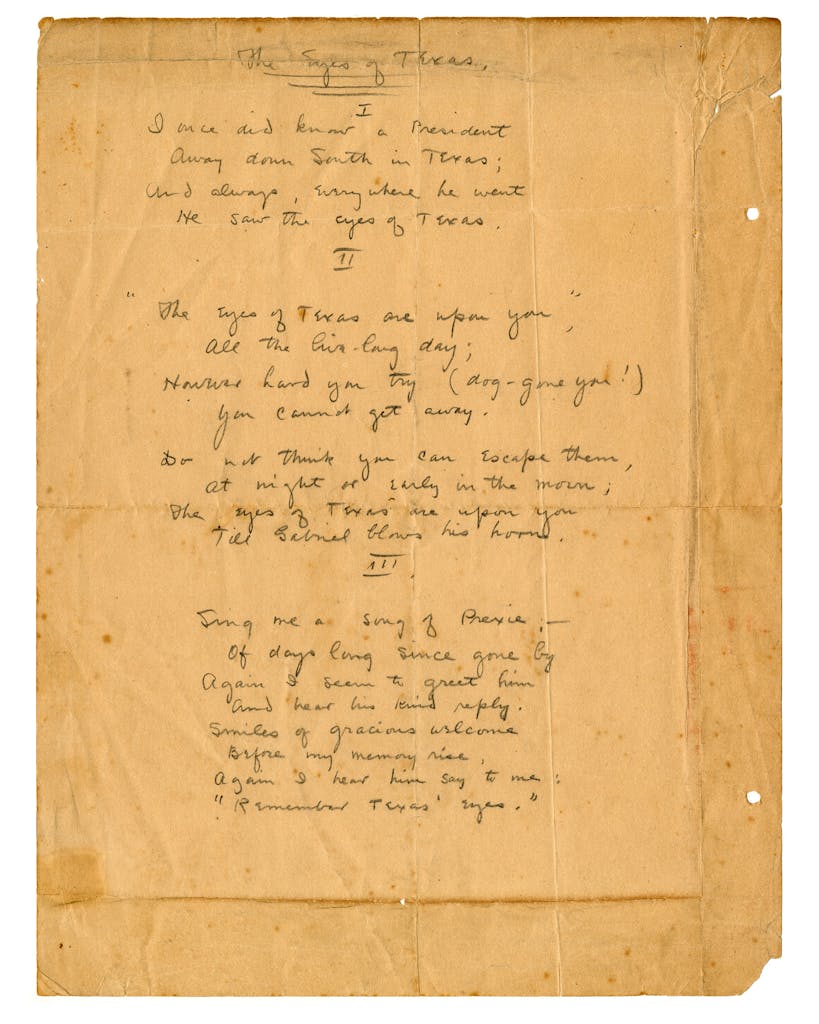
Sinclair seemed to want to spoof the president, and he set the poem to the tune of “I’ve Been Working on the Railroad,” which itself was based on the “Levee Song,” whose lyrics referenced the use of Black labor to build infrastructure across the South. Sinclair wanted the music to be familiar, so those hearing it would pick it up quickly.
The song debuted at a May 1903 minstrel show, the proceeds of which went to the UT track team. Prather was in the large crowd. The evening included skits, dances, and songs, many performed in blackface, and featured other gross stereotypes. A vocal quartet kicked in with the first public performance of “The Eyes of Texas.” It’s almost certain that the singers remained in blackface. The audience so loved the song that it demanded an encore. The quartet performed the song at least four times that night. Soon after, the marching band learned it and paraded through campus as students sang the words. When Prather, who took the song in good humor, died two years later, it was performed at his funeral, and Johnson later wrote that the song then became something closer to a “reverential hymn.”
That journey—from parody to hymn—happened quickly. Soon after the minstrel show, “The Eyes” became an ever-more popular fixture of UT banquets, graduations, and football games. A group of women sang it during a Longhorn football game in 1916, breaking their customary silence in the stands for the first time. Students sang it at the Capitol in 1944, after the UT Regents fired the university’s president for his role in trying to expand opportunities for Black students as a member of the Bi-Racial Conference on Negro Education in Texas. Soldiers sang it before storming the beaches of Normandy.
The message the team took away, again, appeared clear: take on “The Eyes,” and the coach would support his players.
During the Zoom meeting with players, head coach Tom Herman weighed in. Like Del Conte, Herman said this was the first he’d heard of issues with the song. If you want to take that on, he told the team, you better be unified and get your facts right. But he didn’t tell them not to do it. The message the team took away, again, appeared clear: take on “The Eyes,” and the coach would support his players.
Later that day, Herman discussed the meeting on The Herd with Colin Cowherd, a national sports-talk radio show. “When you love somebody the way that we love our players, and you see them hurt and you see them angry and you see them frustrated,” Herman said, “much like a parent, you want to take all of that off of their heart, and you want to put it all on yourself and be there for them and provide some guidance for them.”
You couldn’t script a better message for the head coach to deliver. “Coaches raised me,” Herman said on The Herd. “The reason I got into this job was to have an impact on young men’s lives the way that coaches had on mine.” Some UT players believed that Herman was genuinely trying to make that sort of connection with them. But many others did not.
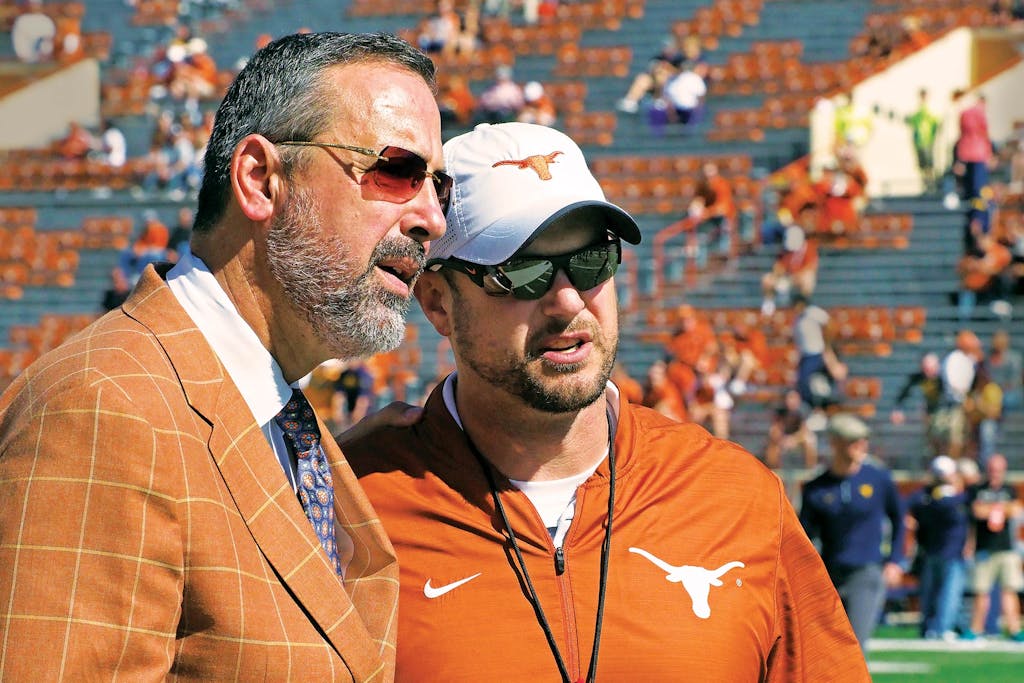
Herman was entering his fourth season in Austin. He’d arrived from the University of Houston, a middling program he’d quickly turned into an unlikely powerhouse. Known as a tactical football prodigy, he’d come to Texas billed as a savior for a proud program that had slipped into mediocrity. But thus far, his record of 25–15, while miles ahead of the numbers posted by his predecessor, Charlie Strong, didn’t match the high expectations of his fan base. Before the season even began, Herman sat on the proverbial hot seat.
Herman had made a bootstrap climb to the top. His father struggled with alcoholism and homelessness. Herman had to ask his high school coach to teach him how to tie a tie. He played wide receiver at Division III California Lutheran University, where he demonstrated such impressive football acumen that, upon graduation, his head coach brought him on staff. And off Herman went: Power Five coordinator at 33; national championship ring under Urban Meyer at Ohio State at 39.
With the Cougars, Herman drew national attention for kissing his players on the cheek before each game. “How do you motivate a human being to do things against his own nature?” Herman said to the New York Times.
“There’s two things: love and fear. And to me, love wins every time.”
But that’s not the Herman described by his players in Austin. He had, one former UT wide receiver said, “a very arrogant attitude and came across as unapproachable.” Once, Herman used the word “diminutive” in a team meeting, then turned to a player and asked, “Do you even know what that means?” According to sources at every level of the program, Herman either had trouble connecting or failed to make it a priority. “One day he may know your name. One day he doesn’t address you,” an athletic administrator said.
“He’s an absolute genius when it comes to you know, statistics, knowledge, all that stuff,” one player said. “What’s lacking is the emotional intellect.”
Herman also kept the Texas alumni at arm’s length, and he rarely allowed former Longhorn players access to his team. “He had not developed any key alliances at a place where it’s really important to have key alliances,” a good friend of Herman’s said. “Some people aren’t wired that way. Tom thinks, ‘My work product is my work product, and it speaks for itself.’ ”
Some coaches have found success this way. Alabama’s Nick Saban turned brusqueness into an art form. Urban Meyer, Herman’s former boss at Ohio State, is an unapologetic autocrat. But at Texas, the only two coaches since World War II to win national championships have been Darrell Royal and Mack Brown. They liked pleasing people, and they moved naturally among the wealthy, powerful alumni and donors who, more than anything, wanted to flaunt their influence and access. Royal and Brown made those Exes, as Texas alumni call themselves, feel as if the head coach cared about their football opinions. The two men also endeared themselves to maintenance workers and others around the Forty Acres. An old hand on campus who worked with them both said they operated under the same mantra: you can judge a man by how he treats someone who can’t do a thing for him.
Herman, who declined through his agent to be interviewed, seemed to have put himself on an island. According to one of the six assistants Herman hired when he overhauled his staff after going 8–5 in 2019, the pitched battle over the “Eyes of Texas” would become “a tipping point.” The assistant added, “There was a lack of trust from the moment I got there.”
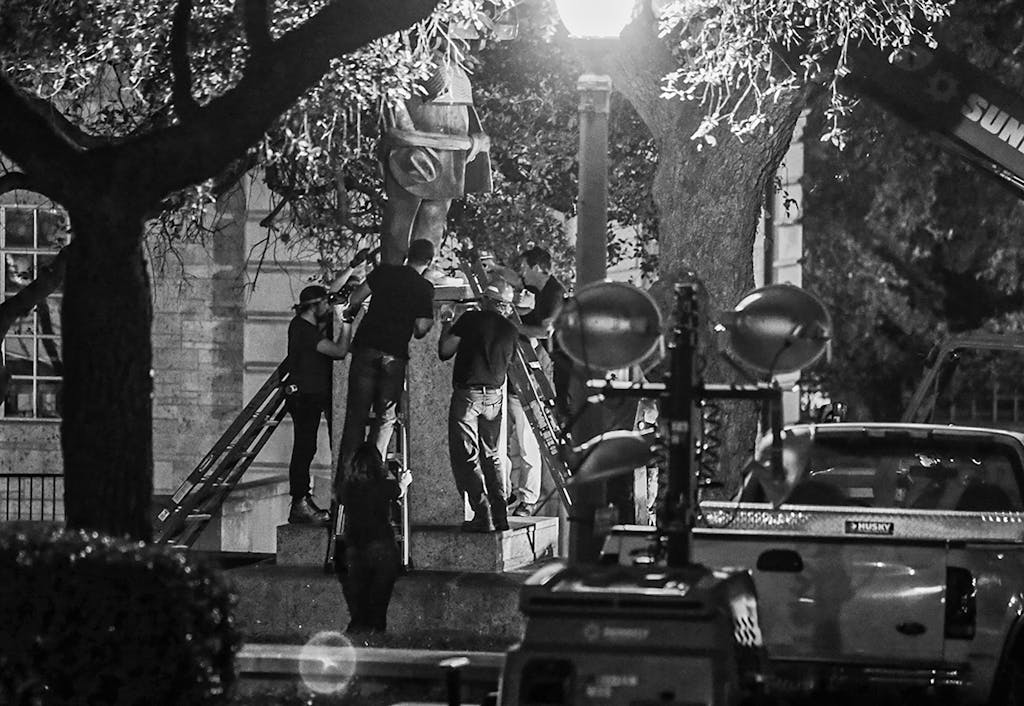
A couple of days after the June 1 meeting, several players started a group chat for those who “wanted to move forward with enacting change,” according to the team captain Ossai. They discussed sitting out the entire season but ultimately decided a boycott would be counterproductive. They could make a larger impact if they utilized the spotlight they attracted on Saturdays in the fall. Six of the players gathered the group’s sentiments and met with a Dallas-based attorney, Abel Mulugheta, to draft a letter of requests to the university.
They then sent it to captains of other Longhorn teams and coordinated a time to release it on social media, at midday on June 12. The student-athletes’ requests included renaming four campus buildings bearing the names of avowed racists and removing a statue of James Hogg, a Texas governor during the Jim Crow era. They asked that statues of a diversity of alumni be erected, that incoming freshmen be given the opportunity to learn about the history of racism on campus, and that the university create an outreach program in the state’s inner cities. At the end of the letter came the request that “The Eyes of Texas” be replaced by a song “without racist undertones.”
The letter went viral. Brennan Eagles, a junior wide receiver, received more than 5,200 likes and more than 1,500 retweets. The players had expected pushback, but the level of vitriol that was unleashed came as a shock, especially when it pertained to “The Eyes.”
Five days after the release of the letter, Del Conte, Herman, and interim university president Jay Hartzell addressed the growing controversy with the team. Hartzell, the former dean of the McCombs School of Business at UT, had been on the job for a little more than two weeks. His position became official in September, but at the time, how he reacted to the strife would play a role in determining whether he got the job. He had never spoken to the football team. He told the players they were bringing change to the university. “I’m proud of you,” Hartzell said.
But the message from Del Conte and Herman lacked the clear support the players thought they had received a few days earlier. “You don’t have to sing [“The Eyes of Texas”] right now, but guess what?” Del Conte said. “There are a lot of guys on the other side of this song that don’t understand why you’re thinking the way you’re thinking.” One player recalls that he felt Del Conte “was trying to play devil’s advocate and be on our side while also being on the donor side. Just shoot it straight, man.” Herman told the players he was hurt because they hadn’t consulted him before releasing the letter. I definitely want to help, he said in the meeting, but don’t go behind my back.
To many players, it sounded as if Del Conte had given them permission to, as Joseph Ossai said, “treat the song like elevator music.”
In the locker room, the meeting didn’t sit right. Many thought Del Conte, Hartzell, and Herman had been dismissive. Juwan Mitchell, a junior linebacker, wrote on Twitter: “For ONCE, we decide to voice our opinions about things that can help better the community. It seems they only got our front but not our backs . . . with that being said, I do not feel comfortable representing The University of Texas.”
The meeting didn’t sit right with certain alumni either. Throughout that month, according to reporting from the Texas Tribune, a group of boosters and big-name alumni pressed university leaders to keep the song. They included many graduates of the McCombs School of Business, where Hartzell had served as dean; Colt McCoy, the former Longhorns quarterback who is now with the Arizona Cardinals; and rich oilmen like Bud Brigham. Bill Stanley, a wealthy chemical engineer whose donations to the school have exceeded $2 million, circulated a letter questioning Hartzell’s leadership specifically for meeting with the players. “This current, highly emotionalized and factually inaccurate movement is counterproductive, will generate more divisiveness and also destroy the progress made in integration up to now,” wrote Stanley. “It is being fomented by socialistic groups that are using the blacks as pawns. It is regrettable that the University has accepted this movement.”
In July, the team again gathered to speak with Del Conte, Hartzell, and Herman. The officials announced that the university had agreed to many of the requests in the letter. Among other initiatives, the university would rename buildings, redistribute some athletic department revenue to “recruit, attract, retain, and support Black students,” and erect a statue of Julius Whittier, the Longhorns’ first Black letterman, outside the stadium.
Then talk turned to “The Eyes.” Del Conte announced that the song would remain. It would still be played after every game, he said, but anyone who felt uncomfortable wouldn’t have to “participate.” Del Conte says now that he never told players they had to stay on the field—because it never crossed his mind that they wouldn’t. To many players, though, it sounded as if Del Conte had given them permission to, as Ossai said, “treat the song like elevator music.”
But even as players accepted the agreement, some felt spurned by what they viewed as a lack of support from their coach. “Come on, man,” one player said. “Don’t start backtracking your word. You encouraged us to do this. Shit just hit the fan ever since.”

For years, the Eyes of Texas had been elevator music. In the football building, the elevator played “Texas Fight” going one way and “The Eyes of Texas” going the other. But in 2020, the elevator went on hiatus. It sat smack in the middle of an ongoing $175 million renovation to the south end zone at Darrell K Royal–Texas Memorial Stadium. When the project is finished this fall, the stadium will feature new luxury suites. Just south of the football stadium, construction is under way for the Moody Center, the university’s new basketball arena. UT is responsible for a portion of its $338 million price tag.
As athletic director, Del Conte is essentially the CEO of a corporation that generated $200.8 million in revenue in the 2019–2020 fiscal year. When the players released their letter, Del Conte was juggling several knives at once: pandemic, civil unrest, and the financial chaos caused by not selling football tickets—chaos that included laying off some 35 staffers and furloughing others. Del Conte said the deficit created by limited ticket sales could have risen as high as $50 million but ultimately settled at $19 million.
Del Conte said that no donors pulled pledges because of “The Eyes.” But the perception became that players and students represented one side of the debate, and wealthy donors represented the other. “The big money loves the song,” said one former Longhorn football staffer. “And now it’s gotten so polarized; it’s gotten like the national anthem to some people.”
Jay Boulware, the Longhorns associate head coach last season who played for Texas in the nineties, said, “I’m a Black alum, my wife is a Black alum, and we both love the school song. It didn’t change because somebody sang it in blackface. This song, to a lot of people, has nothing to do with race. It has to do with school pride.” But when the coaches discussed the issue in a staff meeting, Boulware gave a frank assessment. “This crap,” he said, “is going to get us fired.”
At practice before the September 12 opener against UT–El Paso, a player asked Herman what would happen after the game. Herman replied that the song would be played and said that nobody had to stay on the field if they didn’t want to. He asked them, however, not to kneel.
“But what will you do?” a player asked.
“I’m going to stay out there and throw my horns up,” Herman said. He explained that the university was his employer, and someone had asked him to remain on the field.
“Who?” responded one player.
Herman answered by saying only, “The administration.”
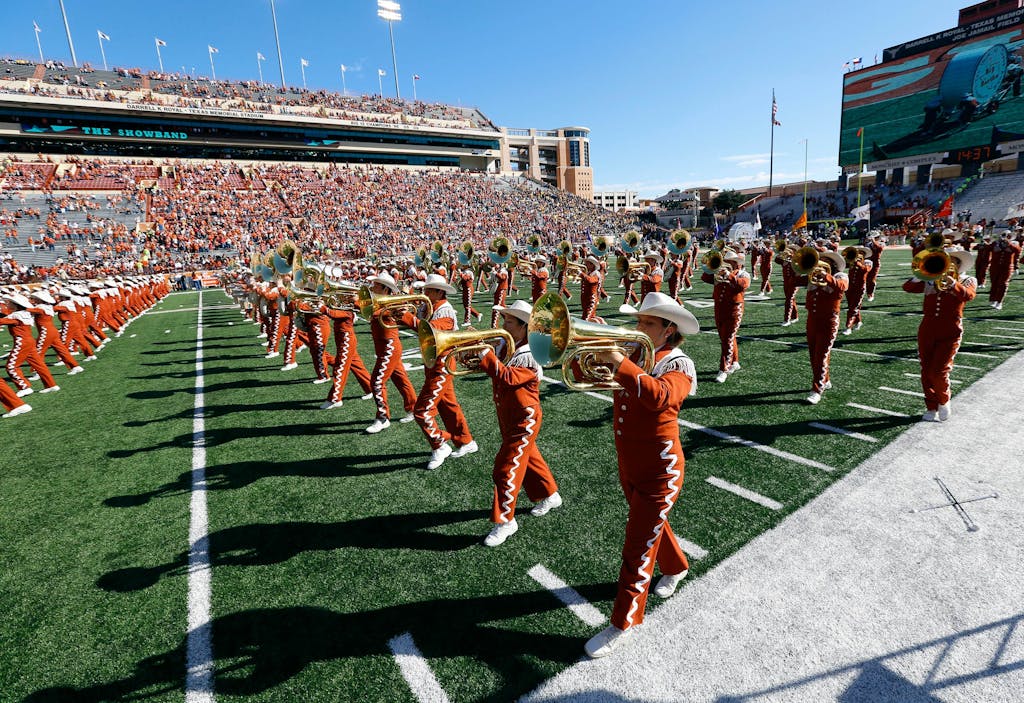
When the Longhorn Band plays “The Eyes of Texas,” the arrangement begins with a 10-second prelude, a long buildup for a piece that the band concludes in 50 seconds. That says something about showmanship, yes, but it also dramatizes the emotions that the song brings to the surface.
Many of UT’s most beloved traditions have shallow roots. The school didn’t officially adopt burnt orange until the mid-sixties, when coach Royal grew tired of the brighter orange uniforms fading to yellow. The “Hook ’em” hand sign dates only to 1955. The UT Tower, the university’s signature building, was finished in 1937. “The Eyes of Texas,” on the other hand, is about as old as the university itself. Nearly everything that’s ever occurred at the University of Texas has been accompanied by the song—for better or worse.
But because of COVID-19 protocols last season, even some of the most hallowed football traditions were put on hold. No one could guarantee that any one game would take place at all. (Texas never did play Kansas last season.) Game days took on an alien feel. The university banned tailgating. The total attendance for the Longhorns’ five home games, 85,690, fell well short of current stadium capacity (100,119). And the Longhorn Band didn’t perform at any games.
Almost immediately after the final whistle of UT’s season-opening 59–3 rout of UTEP, a prerecorded version of “The Eyes of Texas” began emanating from the stadium sound system. Players and coaches, still shaking hands with the Miners, appeared confused that the song began playing so quickly. The team usually gathered to sing it together; now they had to decide what to do on their own. For the majority, it was an easy call. If the song made their teammates uncomfortable, they wouldn’t sing it. “I love my teammates more than I love the song,” said linebacker Cort Jaquess. As the song continued, Herman hugged a UTEP assistant coach. He didn’t put his horns up, nor did he sing. No one seemed to pay any mind.
The Longhorns followed the UTEP win with a 63–56 overtime victory at Texas Tech, their defensive shortcomings casting a pall over any excitement that resulted from moving up to No. 8 in the Associated Press ranking. The following week, TCU did what it has done so often in twenty seasons under head coach Gary Patterson: the Horned Frogs stole a 33–31 victory against a more talented UT team.
Then came Oklahoma. The Sooners arrived at the storied Red River Showdown with a losing record (1–2) for the first time since 1997. Herman’s Texas teams had lost three of four to their rival. But this year, Oklahoma had an inconsistent young quarterback, and Texas had Ehlinger, a four-year starter. Just as he had against Texas Tech, Ehlinger led a dramatic fourth-quarter comeback, scoring two late touchdowns to force overtime. Texas, though, didn’t capitalize on multiple chances to win, and the Ehlinger interception in the fourth overtime ended the game.
Most of the players quickly headed to the locker room, as they had for every game, but this time someone happened to snap the photo of Ehlinger singing the alma mater without his teammates. Austin TV station KXAN tweeted that photo, and suddenly the team was making national headlines once again for non-football reasons.
Some emails suggested that anger from donors was, in some quarters at least, a very real concern.
The wisdom of football’s internal clock dictates that whatever emotion is stirred by a game on Saturday is left behind on Sunday. Win, lose, no matter. A new opponent is on the horizon. But that week, the Texas Longhorns didn’t have a new game to look forward to. Any football veteran can tell you that an off week after a loss can feel longer than Anna Karenina. The players had no imminent challenge to focus on. Instead, they had to return to what by now felt like a very old challenge. The photo of Ehlinger, and the reaction to it, had refreshed the battle over “The Eyes of Texas.”
In the locker room, the prevailing sentiment was confusion. “Why now?” one player remembered thinking. “Why is this a thing now?” All season long, the team had left the field before “The Eyes” played. They felt frustrated, and confounded, as to what had changed. More than anything, they cratered emotionally over the loss to Oklahoma. “If we had won most of these games,” a wide receiver said, “no one would have cared. But because we were losing, fans want to blame something else.”
On Monday, Herman began his weekly press conference by reading a two-minute statement in which he tried to straddle the university’s decision to keep the song and the sentiments of his players who’d shunned it. “We will continue to encourage participation for all of those that are comfortable doing so,” Herman said. “That said, some members of our program have concerns and aren’t comfortable participating at this time, and I respect that as well.”
Outrage among alumni reached a fever pitch. President Hartzell said that threats made via email didn’t influence any of the university’s decision-making—which would make UT the rare university impervious to donor pressures—and he denounced the openly racist messages, of which he said there were few. But some emails suggested that anger from donors was, in some quarters at least, a very real concern. “[Alumni] are pulling planned gifts, canceling donations, walking away from causes and programs that have been their passion for years, even decades, and turning away in disgust. Last night one texted me at 1 a.m., trying to find a way to revoke a seven-figure donation,” Kent Kostka, the president of the Longhorn Alumni Band Charitable Fund board of trustees, wrote to Hartzell and other administrators. “This is not hyperbole or exaggeration. Real damage is being done every day by the ongoing silence.”
On Wednesday, Longhorn football players filed into a meeting room on the eighth floor of the North End Zone. Del Conte framed the “Eyes of Texas” issue as a matter of unity and tradition. At one point, he said simply, “I need your help.” He wasn’t going to make anybody sing, but he asked the team to remain on the field while it played.
One official at the meeting expressed his concern that the 2020 Longhorns might have trouble getting jobs in the state after graduation. “I felt pretty threatened by that,” said a receiver. “I mean, getting a job after football is really important to me.” Others interpreted the message differently. “Some people took this as him threatening us and told us we weren’t going to get a job,” one linebacker said. “I interpreted it as him being concerned.”
When Herman spoke, he reinforced Del Conte’s perspective. But players hardly recognized their normally cocksure coach. “He looked like he was ready to cry,” one player said.
The next day, the team’s leadership council—a collection of players from each position group—met to discuss “The Eyes.” Many vented—about the way the media had portrayed the protests; about losing; about Herman, Del Conte, and everyone else in charge. Mostly, they vented that the issue remained unsettled. Team captain Ossai stood up. “Let’s change this,” Ossai said. “What could we do?”
Some said they weren’t going to budge on their opposition to the song. Things got heated. Then Ehlinger spoke. “We’re here to effect positive change,” he said. “We’ve done that. We will do that. But we’ve got to get better,” he said, referring now to the team’s performance on the field. “We can’t be 2–2.” He clarified what the song meant to him. Every time he sang, he thought of his late dad. It reminded him of going to games with him. It brought back happy memories. He talked about how he had supported his teammates when they released the letter, not because he necessarily agreed or even understood, but because they were his teammates. He looked around the room and focused on Caden Sterns, who’d been the most vocal leader in protesting the song. “Caden, will you stand with me?”
“Yes,” Sterns said.
Ehlinger asked other teammates, one by one. The entire leadership council agreed. Now they had to get the rest of the team on board. At a players-only meeting, Ehlinger delivered a similar speech to the entire team. When Ehlinger finished, Sterns told his teammates that he still wouldn’t sing the song, but he would stay on the field and stand with his quarterback. The team rallied around them.
After the following game, a 27–16 victory at home against Baylor, every player remained on the field. Few sang. Some talked with each other while the song played. Some talked with the cheerleaders. A few knelt.
From that point on, the Longhorns won five of their final six games. But it wasn’t enough to save Herman’s job.
A few days after Texas beat Colorado in the Alamo Bowl, Texas announced as its new head coach Steve Sarkisian, the offensive coordinator for Alabama, and one of the most sought-after coaching prospects in the country. That Texas won the sweepstakes for Sarkisian spoke to the enduring power of the Longhorn brand—and the wealth of its alumni donors (Herman and staff are owed a $24 million buyout). But if UT had any hopes that a new coach would help turn the page on “The Eyes of Texas” controversy, that optimism was quickly dispelled. During Sarkisian’s introductory press conference, when asked about the alma mater, he said, “I know this much. ‘The Eyes of Texas’ is our school song. We’re going to sing that song. We’re going to sing that proudly. That’s our song, and we’re fired up to sing it.”
His comments would make headlines everywhere from the Washington Post to USA Today. A few players were watching the press conference together, sharing a meal. “Aw, shit,” one of them said. “Here we go again.”
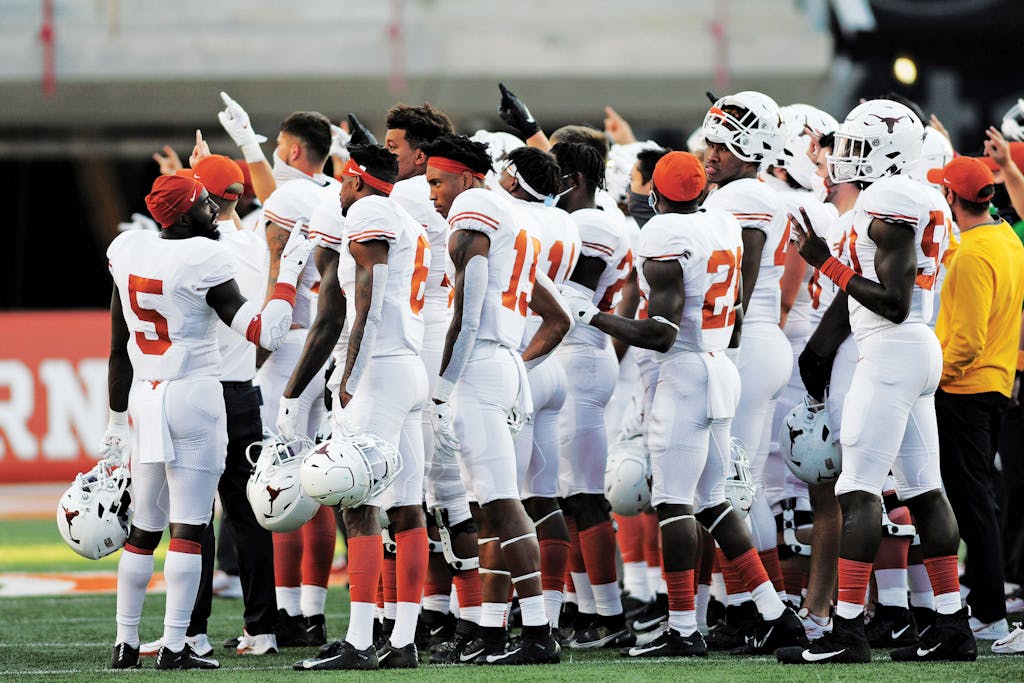
On a foggy Tuesday morning in March, every Longhorn student-athlete had an early wake-up call. They’d been summoned to the Frank Erwin Center, the basketball arena on the edge of campus, at 8 a.m., to hear the results of a much-anticipated report on “The Eyes of Texas” that Hartzell had commissioned months earlier. He’d tasked a 24-person committee that included current students, historians, alumni, faculty, and current and former athletes with examining the history of “The Eyes.”
Hartzell addressed the athletes and emphasized his pride in what they had started the previous summer, to make the campus more inclusive and welcoming to Black students. Then he turned it over to the head of the committee, Richard Reddick, the associate dean for equity, community engagement, and outreach in the UT College of Education. He and others unveiled the major findings of the roughly fifty-page report. It confirmed that the song had been first performed at a minstrel show: “That ‘The Eyes of Texas’ was most probably debuted in blackface is a painful reality of the song’s origin. We are uncomfortable with this aspect of its history. We believe it is important to fully acknowledge and learn from the university’s past.”
The report ultimately concluded that the lyrics had “no racist intent.” Though the song debuted at a minstrel show, the commission said they found no evidence that it was written specifically for minstrelsy. More likely, they said, the song’s creators wanted only to premier their work at a well-attended event. The report further contended that the lyricist, Sinclair, did not write in dialect, a common form of stereotyping in that era. It also dispelled the widely held belief that the phrase “The Eyes of Texas” was inspired by a favorite saying of Confederate general Robert E. Lee, though it did confirm connections to a different Confederate officer, brigadier general John Gregg of Texas.
Backlash to the report came quickly, with some vehemently disputing its conclusions.
Backlash to the report came quickly, with some vehemently disputing its conclusions. Alberto A. Martinez, a UT history professor, published his own report on the song, including evidence that it was specifically written for the 1903 minstrel show. He cited a 1926 Dallas Morning News article written by Prather’s daughter, Mary Lu Prather Darden, describing exactly that. At a March 29 press conference at the Capitol, Martinez, along with a group of students, legislators, and Texas NAACP President Gary Bledsoe, argued that the university contradicts itself when it says that a song that originated in a minstrel show has no racist intent. “We ought to make it clear,” said Bledsoe, “that the report issued by the twenty-four-member committee should not be used to sanitize or justify a song that debuted in minstrel shows with lyrics that were embraced because of lore that connected them to Confederate general Robert E. Lee.”
In a university-wide email, Hartzell wrote of wanting to make UT a pioneer of a “new model for hard conversations.” He suggested that “The Eyes of Texas” report is a first step in that process. “It seems strange for an institution of higher education that does research and teaches, to not do research and then teach,” Hartzell said later. “How can this issue that’s so difficult about race in our society not be one where we do the research and we teach?”
Hartzell also reaffirmed that—contrary to earlier suggestions by Del Conte and Sarkisian—players won’t be required to stay on the field for “The Eyes of Texas.” When the 2021 season begins on September 4, a home game against the University of Louisiana at Lafayette, Ehlinger will have graduated, and promises by other players to stand for the alma mater presumably will have expired. Much attention will be paid to who remains when—and if—the Longhorn Band strikes up the song.
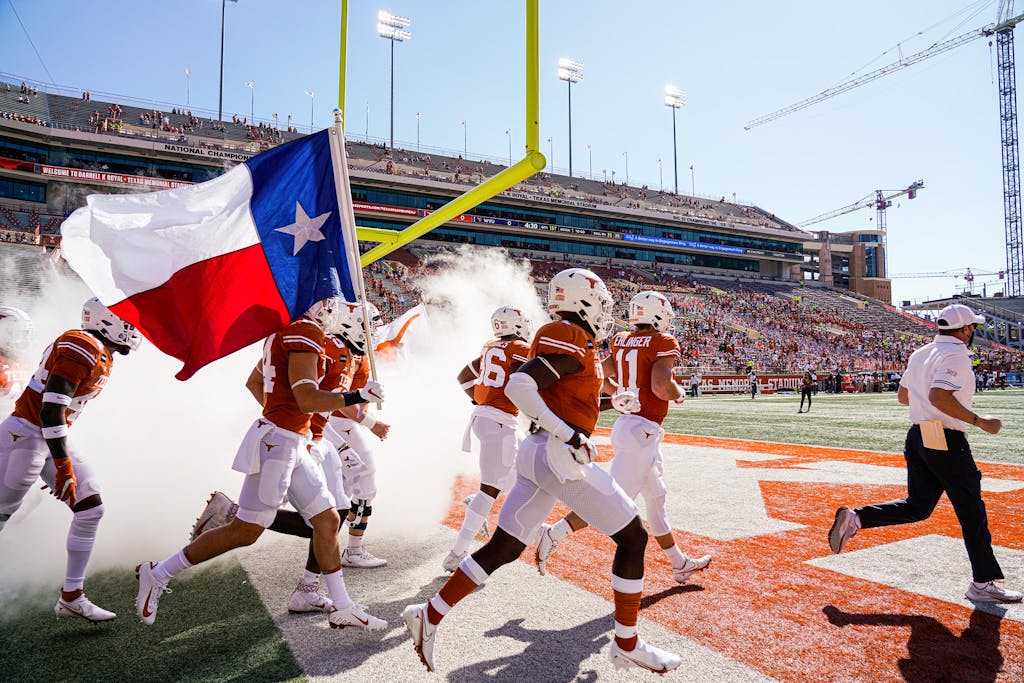
Texas is not the first school to have trouble coming to terms with racial symbols. Ole Miss banned the Confederate flag from its football games in 1997. It took nineteen more years for the university to also ban the playing of “Dixie.” Many Ole Miss alums were persuaded the song needed to go only after evidence was presented that it was harming recruiting for the football team. According to the sports website The Athletic, Texas’s commitment to its alma mater is already being used by other colleges as a tool to dissuade top high school players from signing on as Longhorns, though there’s no evidence that it’s working. Texas has lined up yet another strong recruiting class.
Throughout the day that the university’s report on “The Eyes” was released, the Longhorn teams met to further discuss its findings. At 6 p.m., the football players gathered once again in the team room in the North End Zone. Many of the leaders from the 2020 team were off campus. Ehlinger, Ossai, and Sterns were preparing for the NFL Draft. Sarkisian addressed the remaining players with more nuance than he had used at his press conference. He reinforced the message that Hartzell delivered about the importance of working from a common set of facts. Spring break was a week away. Sarkisian assigned everyone homework: read the report, and then they could have deeper conversations about it.
The players filed out of the stadium, where the newly erected, twelve-and-a-half-foot-tall bronze statue of Julius Whittier stood. For much of the last half century, Whittier, who died three years ago, was the answer to a trivia question. Who was the first Black UT football letterman? Many Longhorn fans had never heard his name. That changed last summer.
Whittier first put on a UT helmet fifty years before the 2020 athletes wrote their letter. Even then, it seems he had an inkling that his impact on the university would grow with time. One night in 1970, the story goes, Whittier and Billy Dale, the white running back who volunteered to room with him, were talking. “Billy, I’m never going to die,” Whittier told Dale. “And you are.”
Dale didn’t understand. He was the upperclassman, the starter, the team leader. Whittier rode the bench at the time. What was he talking about?
Whittier replied, “I’m just trying to make you think.”
Ivan Maisel has covered national college football since 1987, including for the Dallas Morning News, Sports Illustrated, and ESPN. Joe Levin, a former Texas Monthly intern, is a senior at UT.
